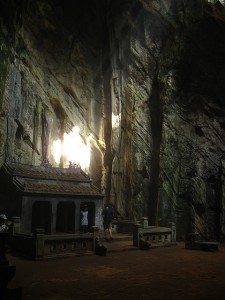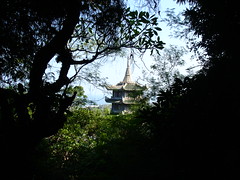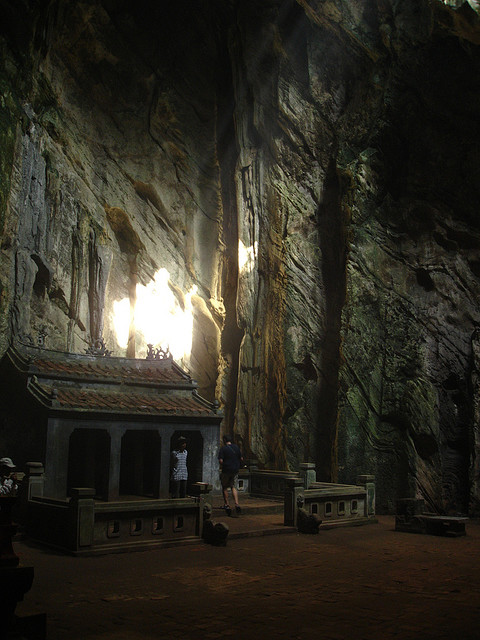
There’s a buzz that reverberates through the little town of Non Nuoc. A shrill energetic hum that seemingly has no single source.
Rather, it comes at you from every nook and cranny, every side street and alleyway. Literally bouncing off the walls.
An industrious, dusty hum that fills the day, the only reprieve coming at noon, when lunch, as always in this country, takes precedence over all other endeavours.
Sitting at the foot of the marble mountains, Non Nuoc is home to Vietnam’s marble carvers who chisel and sand their intricate and ornate creations beneath the mountains that once provided them with their raw materials.
These days the marble is mainly imported from China, but it is the skill of the craftsmen of Non Nuoc, which transforms these huge formeless white slabs into objects of desire that are shipped across the globe, to grace the gardens and lobbies of wealthy patrons with an inexplicable taste for kitsch.
If garganutan faux classical statues are your thing, then Non Nuoc is most definitely the place for you.
If staring at numerous incarnations if Venus de Milo or the Three Graces, isn’t quite your thing though, then no matter, because the marble mountains themselves are well worth the visit.
The five marble outcrops which make up the mountains are named after natural elements: water, earth, wood, metal, fire.
Of the five it is Thuy Son (Water Mountains) which is the most impressive.
A stone paved path winds its way steeply up the mountain. As you climb, secret alcoves chiselled into the rock appear, revealing splendid statues of Buddha.
The majority of these statues are, surprisingly enough, made of concrete, but for all this, they have the strange effect of appearing to have emerged from the rock itself, as if the marble fell away to reveal these graceful contemplative figures.
 Winding slowly upwards, the views through the trees down to China Beach and the South China sea are breathtaking.
Winding slowly upwards, the views through the trees down to China Beach and the South China sea are breathtaking.
From the rock, the vast expanse of sea seems endless and perfect, and it is easy to see why the Linh Ong Pagoda and Buddhist monastery are situated here. It seems naturally made for religious contemplation.
During the Vietnam war this fortuitous vantage point, which looked out over the then US controlled beaches, meant that the caves were used extensively by the Vietcong as munitions depots and field hospitals, and bullet holes still mark the rocks today, a stark reminder that in times of war, nothing is sacred.
Impressive as all of this is however, nothing can prepare you for what is to come.
A never ending staircase behind the pagoda winds its careful way ever upwards revealing numerous caves and openings that house yet more statues and little altars.
As you weave your way through the intricate and disorienting network of caves you are suddenly confronted with an entrance that opens out into the vast cavern that is the Huyen Khong Cave.
I say cave here, but in actually fact, the vast dark hollow resembles more some huge natural cathedral. A place that has been granted majesty and spirituality by nature.
That may sound overblown and mystical, but the impressiveness of Huyen Khong really does provoke such a level of awe.
People wander around in respectful silence, stunned perhaps by the huge ceiling which rises up a good twenty meters or so, to an opening which allows rays of yellow sunlight to filter through and illuminate the altar at one end of the cave like a spotlight.
It’s like walking into one of the great European cathedrals such as Chartres, only this is a fabrication of nature as much as man which, for my mind, makes it even more impressive.
We wander around there for close on half an hour, reluctant to leave and it is only Mr Nguyen’s insistence and impatience that finally gets us going.
Out in the glare of the sun he suddenly seems quite sprightly and excited, as we leave the caves behind and head back down to town.
It’s strange because for most of the trip so far he has been remarkably reticent for a tour guide, but something definitely seems to be perking him up.
It’s only when we arrive in town that the reason becomes apparent.
The whole place is eerily silent. Tools have been downed, and work seems forgotten.
Which means only one thing. I look at the time.
Yup! It is indeed midday.
Lunch!
The Vietnamese love their food and rightly so. The variety and pungency of the dishes on offer is staggering and delicious.
If Mr Nguyen feels silenced by the guidebooks, and the extensive knowledge they seem to provide, then lunch is one area where the guide books cannot hope to compete.
So it is that we find ourselves sitting in a small, spartan building which I had first assumed was some sort of garage when we passed by earlier in the day.
Not so.
For this unassuming place is, according to Mr Nguyen, the best place for a bowl of Pho in the whole of town.
Basically Pho is a fragrant soup of meat, vegetables, herbs and rice noodles, a description which really doesn’t do the thing justice. You have to get a smell and a taste of it to fully appreciate just how satisfying this dish is in reality.
As a vegetarian though, I don’t really feel best placed to describe it, eating as I did, improvised vegetarian versions.
All I will say is that the Vietnamese seem to run on the stuff and judging from the contented satisfied looks on people’s faces when they eat it, it is apparently divine.
In the little garage cafe the owners seemed utterly dumbfounded when Mr Nguyen explains that I require some vegetarian alternative.
“What? No meat?”
“No.”
“No fish either?”
“Err, no….”
At first this illicits curious looks, which quickly turn to sympathy before dissolving into shrugs of resignation.
“Your loss†they seem to suggest before getting down to the business of whipping up a fresh bowl of this national staple for everyone else.
The room buzzes with activity as vegetables are flashed through sizzling oil, strips of beef quickly braised and pungent fish stock heated.
The aromatic smell of the herbs infuses the air and I catch the restaurant owner smiling at me as he notices me sniffing appreciatively.
“You sure?†he beckons, holding out the hot pan towards me with a raised eyebrow.
I just shrug and smile and he laughs.
As the bowls are delivered to the table, his wife, in some act of sympathy or embarrassment, serves me up a pot of piping hot green tea, no doubt confused as to why I am sitting unfed at the table, while the rest of the gang tuck in with gusto, slurping up noodles and chewing on succulent morsels of beef.
I’m missing out on something, and I know it.
Because this country does seem to define itself in so many ways by its food, something we seem to be losing in the fast-food, processed, junk filled west.
I mean, when was the last time you were in a town where everything stopped for lunch?
